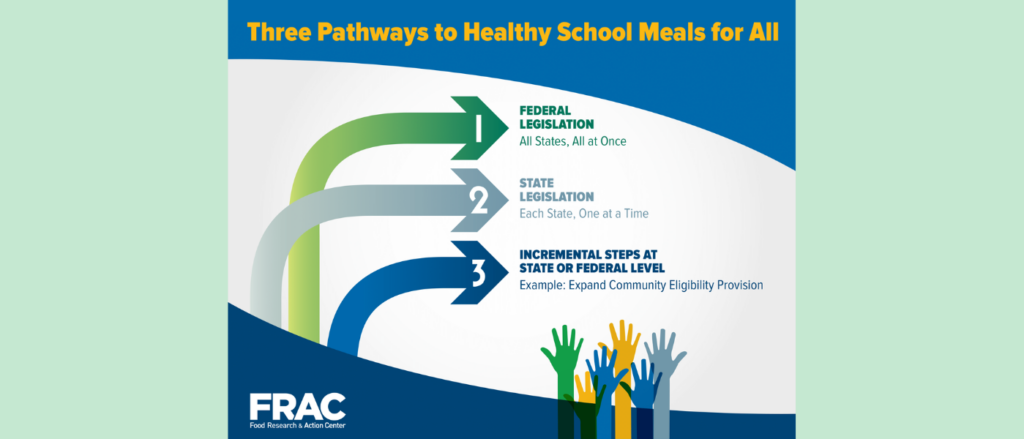February 15, 2024
Five states had Healthy School Meals for All policies in place during the 2022-2023 school year and the Food Research & Action Center’s (FRAC) new report, The State of Healthy School Meals for All: California, Massachusetts, Maine, Nevada and Vermont Lead the Way, highlights the positive impact they had on students and school nutrition departments.
School meals have always played an important role in reducing childhood hunger, supporting good nutrition, and ensuring that students can get the most out of their school day. For more than two school years during the height of the COVID-19 pandemic, schools were able to offer meals to all students at no charge through the pandemic-related child nutrition waivers offered by the U.S. Department of Agriculture (USDA). This served as a trial run for nationwide Healthy School Meals for All, and it was a resounding success.
After the end of the waivers, several states decided they did not want to return to pre-pandemic school meal operations, which required determining children’s eligibility for free, reduced-price, or paid meal categories, and introduced legislation to permanently provide free school meals for all students.
The FRAC report measures the reach of school breakfast and lunch in states that had Healthy School Meals for All policies in place for the 2022–2023 school year. It looks at participation data from September to May, primarily comparing pre-COVID-19 pandemic operations in the 2018–2019 school year to the first year of Healthy School Meals for All policies in the 2022–2023 school year.
Key findings of the report include:
- School lunch participation in California, Maine, Massachusetts, Nevada, and Vermont — the five states that implemented Healthy School Meals for All policies during the 2022–2023 school year — increased compared to pre-pandemic participation levels.
- Student breakfast participation increased in four of the five states but not as dramatically as lunch participation, showing there is still room for growth in the School Breakfast Program.
- The response to Healthy School Meals for All policies has been positive, with state child nutrition agencies noting many benefits to providing school meals at no cost to all families and public opinion polling showing broad support.
The California state child nutrition agency summarized the impact of their policy by noting it “helps to remove stigma of school meals, eliminates school meal debt, increases access to healthy complete meals, and elevates the importance of school nutrition and culinary professionals and the essential role school meals and food service has in a holistic educational programming for student achievement.”
There are several pathways to Healthy School Meals for All, and FRAC recommends the following strategies to ensure all students have access to the nutrition they need:

- Congress should pass a nationwide Healthy School Meals for All policy. The five states that implemented Healthy School Meals for All policies in the 2022–2023 school year, along with the four states that have passed policies implemented in the 2023–2024 school year and the positive polling data, demonstrate the public support and the benefits of serving healthy meals at no cost to students during the school day. Students in all states need access to school breakfast and lunch to grow and thrive.
- More states should continue to pass Healthy School Meals for All policies. States often lead the way, enacting policies that support children and families that become the models for national legislation. Until Congress acts, states can continue to pass Healthy School Meals for All legislation, which to date have passed as standalone bills, have been included in budget bills, and have been approved by voters through a ballot measure.
- The Community Eligibility Provision needs to be financially viable for more schools. In September 2023, USDA released a final rule that lowered the Community Eligibility Provision eligibility threshold from 40 percent to 25 percent Identified Student This allows more high-need schools to serve healthy school meals to all students at no cost to families through community eligibility; however, the multiplier that determines community eligibility schools’ federal reimbursement must be increased by Congress from 1.6 to 2.5 so that it is financially feasible for more eligible schools to participate.
- School districts should take steps to increase breakfast participation. The first five states to implement Healthy School Meals for All policies show that even when breakfast is offered at no cost, students still participate less than they do in lunch. There are additional barriers to breakfast participation, such as students not having enough time to get breakfast in the school cafeteria before the school day begins. Innovative breakfast models, such as breakfast in the classroom, grab and go breakfast, and second chance breakfast, can help close the gap between breakfast and lunch participation.

